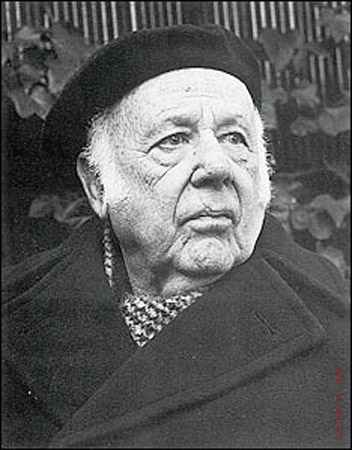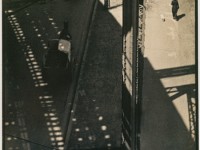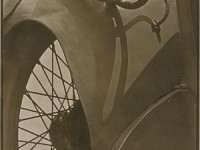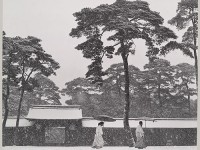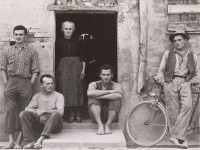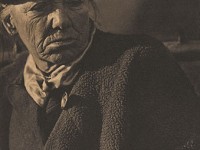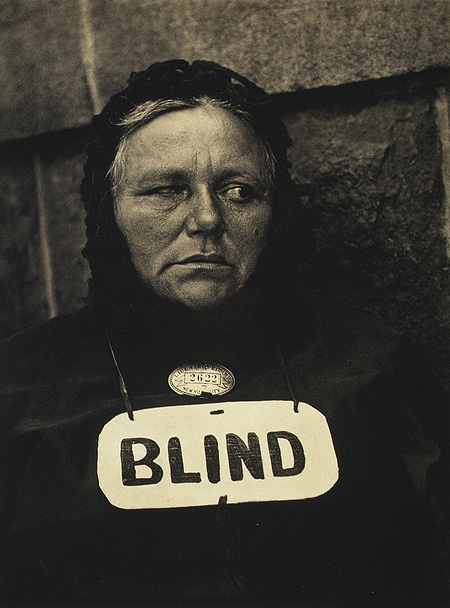A New Insight into Photography
Nominate a Photo Icon Example: Text by Claire Roos, adapted by Citizen Film.
An icon in history, whether a moment, a person, or a photograph, is something that stands out from the rest of its kind, acting as a defining force that shapes its followers to come. In the area of photography, many Jewish photographers in the early twentieth century created one-of-a kind works that helped bring photography into a modern age of art. One of these people, Paul Strand, is said to have brought on the era of modern photography with his photographs at that time period. His portrait titled Blind proved to be an iconic photo through its stark contrast from the overriding photographic styles and intellectual movements of the time.
Paul Strand sought to set himself apart from the societal norm as his passion for new and innovative art forms grew. Born to Jewish-Bohemian immigrants in New York in 1890, he learned of his passion for photography at the Ethical Culture School through the assistance of his teacher, Lewis Hine. After traveling through Europe, he formed a desire to succeed in the world of photography, yet had trouble creating a name for himself in spite of his efforts. His travels left him with a pictorialist style that was common at the time. This entailed an idealistic approach to photography through the beautification of artistic elements instead of a true documentation of reality. Realizing that this technique was not propelling his work, Strand consulted with the prodigious Alfred Stieglitz. Through the mentorship of Stieglitz and Strand’s subsequent exploration of European modern art, he set out to make a stand in the photography world.
Click on a photo to enlarge.
- From the El, 1915
- Wire Wheel, 1917
- Rebecca, New York, 1916
- In the court of the Meiji Temple, Tokyo, Japan, 1952
- The Lusetti Family, Luzzara, Italy, 1953
- Portrait, New York, 1916
Strand’s Blind demonstrates the culmination of his influences to create a striking piece. Contrary to the carefully manipulated picturesque photographs of his contemporaries, the aesthetic composition of this portrait has strong relations to Picasso’s cubism, Stieglitz’s “straight” photography, and the documentary style of his former teacher, Hine. In light of the documentary style, the candidness of the un-staged subject, the woman, aims to portray the world in a real way. Unlike the blossoming intellectuals of the time who sought to redefine American culture, Strand focused on ordinary people in a very natural and simple sense.
In this “straight” style, Strand defined his photograph with a minimal number of crucial elements: The woman’s asymmetrical position of eyes, her dark shall, the “BLIND” sign, and the diagonal bricks of the background leave us with a very direct and non-idealized impression. Additionally, the simplicity of the basic shapes, including the circular face, oval sign, and square bricks strongly hint at cubist origins.
I remember coming across Paul Strand’s Blind Woman when I was very young, and that really bowled me over. . . . It’s a very powerful picture. I saw it in the New York Public Library file of Camera Work, and I remember going out of there over stimulated: That’s the stuff, that’s the thing to do.
It charged me up.–Walker Evans, American photographer
After its presentation in Stieglitz’s journal Camera Work, the Blind left its viewers shocked at its unyielding directness; her blatant disfigurement dominates the frame. Strand achieved this further through the social matrix in which he took the photograph: fascinated by her dignity in spite of her condition, he chose to portray the woman simply as an anonymous subject, restricting the frame to eliminate any external elements that could lead toward a deeper social meaning. This additionally relates to the semiotic context, in which Strand makes apparent her disability with the presentation of the woman’s disfigured eyes and prominent sign, but hides any hint of her current actions, such as peddling. Thus, she is not pitied and is left to be interpreted solely in a literal, “straight” manner. In this way, Strand set himself apart from his symbol-loving contemporaries.
Strand’s realistic and direct approach in the Blind came to mark a transition in America toward a modern epoch of photography. Steering clear from the heavily manipulated and symbolic photographs of others during his time, this portrait dares the viewers to simplify their minds and appreciate art in a completely visual way. Just as the woman’s blank eyes mystify the viewer, so did her candid portrayal to the early twentieth-century art world.
Sources
Image Sources
Strand, Paul. The Metropolitan Museum of Art , “Blind, 1916.” <http://www.metmuseum.org/toah/works-of-art/33.43.334>
Strand, Paul. The Metropolitan Museum of Art, “From the El, 1915.” <http://www.metmuseum.org/toah/works-of-art/49.55.221>
Strand, Paul. The Metropolitan Museum of Art, “In the court of the Meiji Temple, Tokyo, Japan, 1952.” <http://www.metmuseum.org/toah/works-of-art/59.559.4>
Strand, Paul. The Metropolitan Museum of Art, “The Lusetti Family, Luzzara, Italy, 1953.” <http://www.getty.edu/art/gettyguide/artObjectDetails?artobj=51750&handle=li>
Films Not Dead, “Paul Strand portrait.” <http://www.filmsnotdead.com/2012/02/24/strand-under-the-darkcloth/>
Strand, Paul. The Metropolitan Museum of Art, “Portrait, New York, 1916.” <http://www.getty.edu/art/gettyguide/artObjectDetails?artobj=61917&handle=li>
Strand, Paul. The Metropolitan Museum of Art, “Rebecca, New York, 1916.” <http://www.metmuseum.org/toah/works-of-art/1989.1135>
Strand, Paul. The Metropolitan Museum of Art, “Wire Wheel, 1917.” <http://www.metmuseum.org/toah/works-of-art/49.55.318>
Links
Department of Photographs. The Metropolitan Museum of Art, “Walker Evans.” <http://www.metmuseum.org/toah/hd/evan/hd_evan.htm>
Ethical Culture Fieldston School. <http://www.ecfs.org/>
Hostetler, Lisa. The Metropolitan Museum of Art , “Alfred Stieglitz.” <http://www.metmuseum.org/toah/hd/stgp/hd_stgp.htm>
Hostetler, Lisa. The Metropolitan Museum of Art , “Pictorialism in America.” <http://www.metmuseum.org/toah/hd/pict/hd_pict.htm>
Rewald, Sabine. The Metropolitan Museum of Art, “Cubism.” <http://www.metmuseum.org/toah/hd/cube/hd_cube.htm>
Roseblum, Noami. The Museum of Modern Art , “Lewis W. Hine.” <http://www.moma.org/collection/artist.php?artist_id=2657>
Quote
Walker, Paul. The J. Paul Getty Museum. <http://www.getty.edu/art/gettyguide/artObjectDetails?artobj=268078>
Video Source
Walker, John. “Paul Strand: Under the Dark Cloth.” <http://www.youtube.com/watch?v=h4gwxS5oLks>















